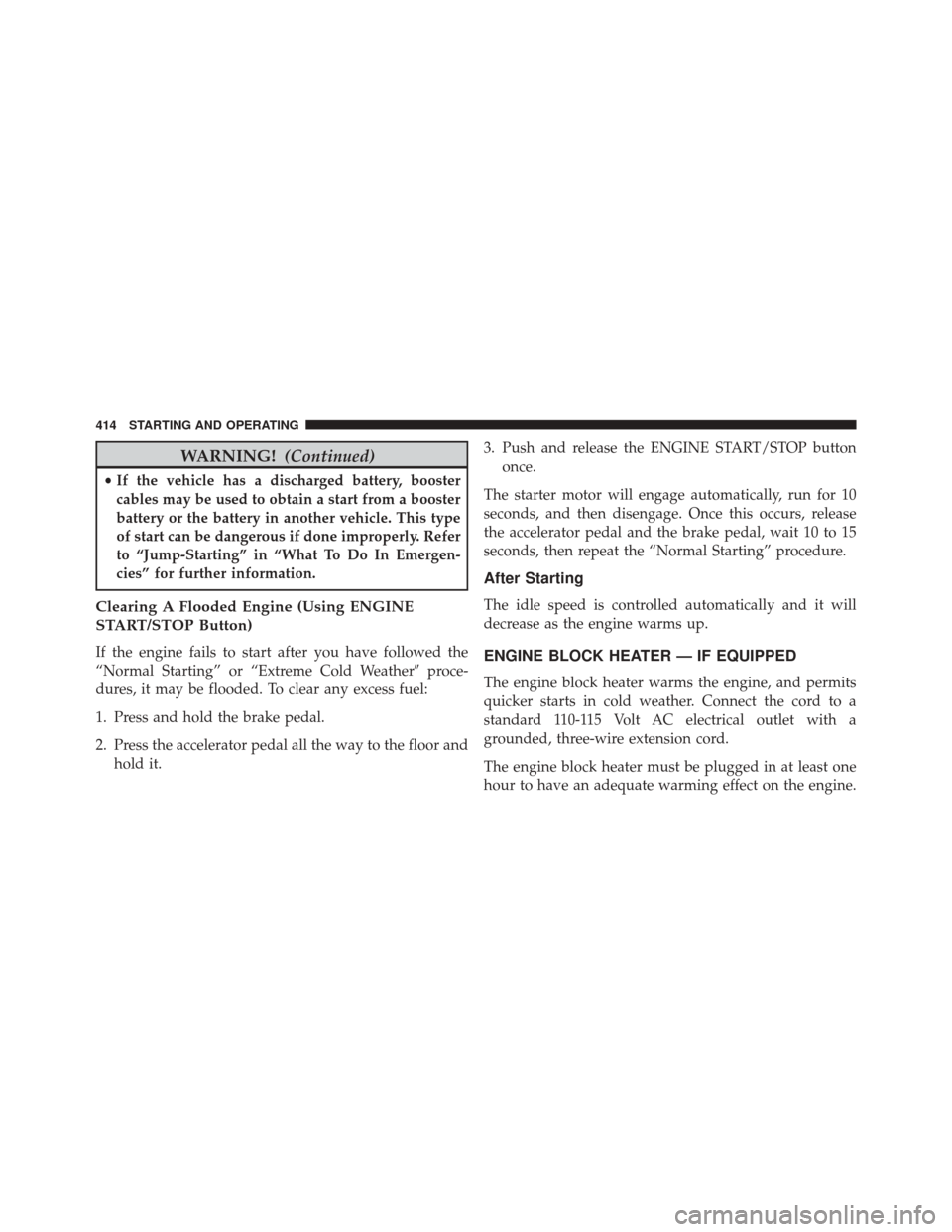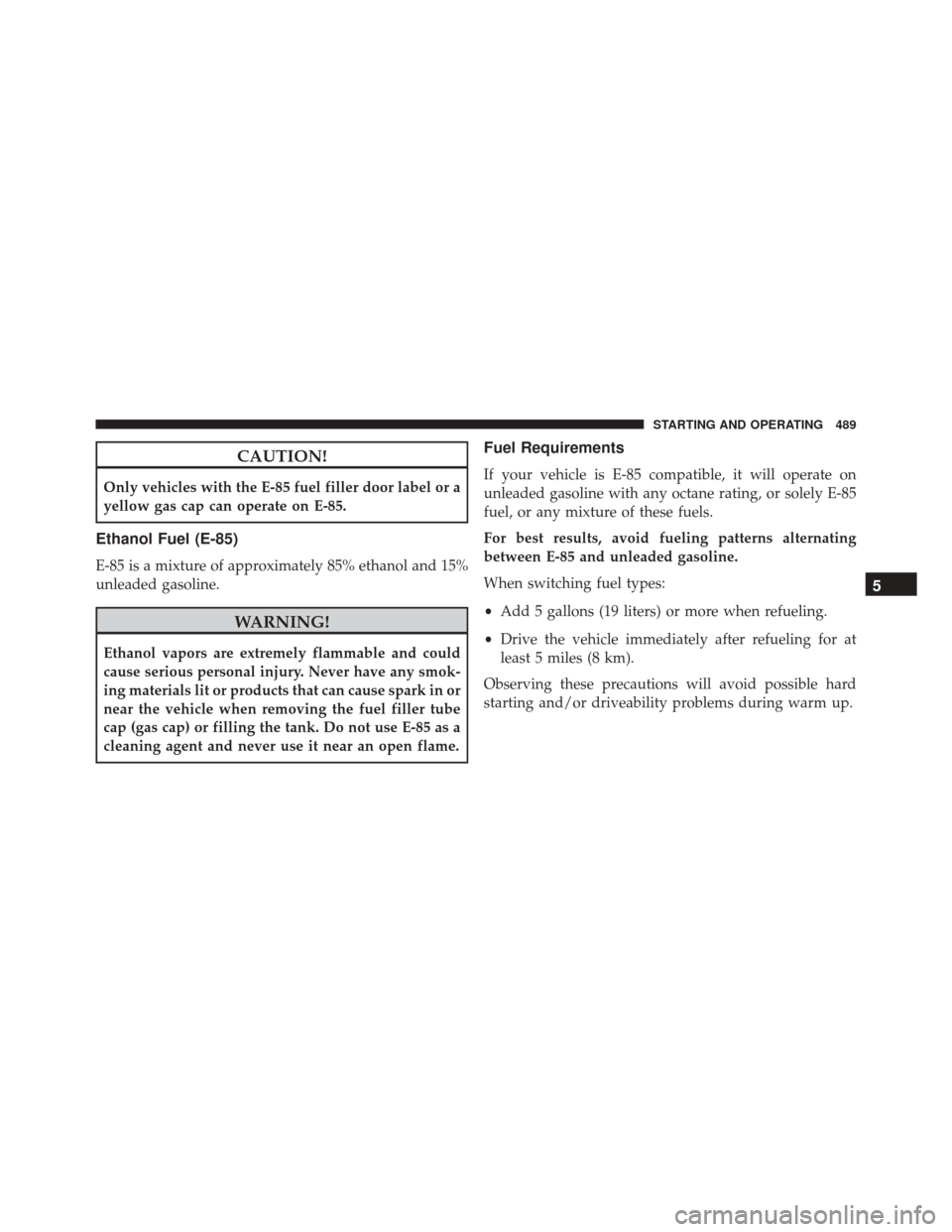Page 287 of 661
CAUTION!
The TPMS has been optimized for the original
equipment tires and wheels. TPMS pressures and
warning have been established for the tire size
equipped on your vehicle. Undesirable system opera-
tion or sensor damage may result when using re-
placement equipment that is not of the same size,
type, and/or style. Aftermarket wheels can cause
(Continued)
CAUTION!(Continued)
sensor damage. Using aftermarket tire sealants may
cause the Tire Pressure Monitoring System (TPMS)
sensor to become inoperable. After using an after-
market tire sealant it is recommended that you take
your vehicle to an authorized dealership to have your
sensor function checked.
Low Fuel Indicator Light
Yellow Telltale
Light What It Means
Low Fuel Indicator Light
When the fuel level reaches approximately 1.5 gal (5.8 L) this light will turn on, and remain
on until fuel is added.
4
UNDERSTANDING YOUR INSTRUMENT PANEL 285
Page 409 of 661

▫Tire Terminology And Definitions ..........456
▫ Tire Loading And Tire Pressure ...........457
� TIRES — GENERAL INFORMATION ........462
▫ Tire Pressure ....................... .462
▫ Tire Inflation Pressures .................464
▫ Tire Pressures For High Speed Operation . . . .465
▫ Radial Ply Tires ..................... .466
▫ Tire Types .......................... .466
▫ Run Flat Tires — If Equipped .............468
▫ Spare Tires — If Equipped ...............469
▫ Tire Spinning ....................... .471
▫ Tread Wear Indicators ..................472
▫ Life Of Tire ........................ .472▫
Replacement Tires .....................473
� TIRE CHAINS (TRACTION DEVICES) .......475
� TIRE ROTATION RECOMMENDATIONS .....476
� TIRE PRESSURE MONITOR SYSTEM (TPMS) . .477
▫ Premium System ..................... .480
▫ General Information ....................483
� FUEL REQUIREMENTS ..................483
▫ 3.6L Engine — If Equipped ...............483
▫ 5.7L Engine — If Equipped ...............484
▫ Reformulated Gasoline .................484
▫ Gasoline/Oxygenate Blends ..............485
▫ E-85 Usage In Non-Flex Fuel Vehicles .......485
▫ MMT In Gasoline .....................486
5
STARTING AND OPERATING 407
Page 416 of 661

WARNING!(Continued)
•If the vehicle has a discharged battery, booster
cables may be used to obtain a start from a booster
battery or the battery in another vehicle. This type
of start can be dangerous if done improperly. Refer
to “Jump-Starting” in “What To Do In Emergen-
cies” for further information.
Clearing A Flooded Engine (Using ENGINE
START/STOP Button)
If the engine fails to start after you have followed the
“Normal Starting” or “Extreme Cold Weather� proce-
dures, it may be flooded. To clear any excess fuel:
1. Press and hold the brake pedal.
2. Press the accelerator pedal all the way to the floor and hold it. 3. Push and release the ENGINE START/STOP button
once.
The starter motor will engage automatically, run for 10
seconds, and then disengage. Once this occurs, release
the accelerator pedal and the brake pedal, wait 10 to 15
seconds, then repeat the “Normal Starting” procedure.
After Starting
The idle speed is controlled automatically and it will
decrease as the engine warms up.
ENGINE BLOCK HEATER — IF EQUIPPED
The engine block heater warms the engine, and permits
quicker starts in cold weather. Connect the cord to a
standard 110-115 Volt AC electrical outlet with a
grounded, three-wire extension cord.
The engine block heater must be plugged in at least one
hour to have an adequate warming effect on the engine.
414 STARTING AND OPERATING
Page 491 of 661

CAUTION!
Only vehicles with the E-85 fuel filler door label or a
yellow gas cap can operate on E-85.
Ethanol Fuel (E-85)
E-85 is a mixture of approximately 85% ethanol and 15%
unleaded gasoline.
WARNING!
Ethanol vapors are extremely flammable and could
cause serious personal injury. Never have any smok-
ing materials lit or products that can cause spark in or
near the vehicle when removing the fuel filler tube
cap (gas cap) or filling the tank. Do not use E-85 as a
cleaning agent and never use it near an open flame.
Fuel Requirements
If your vehicle is E-85 compatible, it will operate on
unleaded gasoline with any octane rating, or solely E-85
fuel, or any mixture of these fuels.
For best results, avoid fueling patterns alternating
between E-85 and unleaded gasoline.
When switching fuel types:
•Add 5 gallons (19 liters) or more when refueling.
• Drive the vehicle immediately after refueling for at
least 5 miles (8 km).
Observing these precautions will avoid possible hard
starting and/or driveability problems during warm up.
5
STARTING AND OPERATING 489